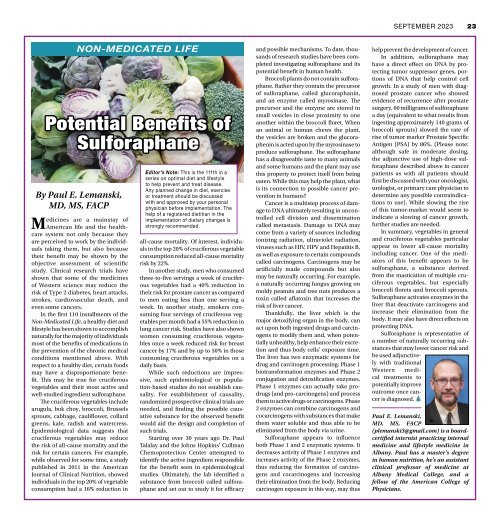Adirondack Sports September 2023
In this Issue 5 NEWS BRIEFS 7 HIKING: Buck Mountain 11 BICYCLING: Upstate Mountain Bike Boom 15 RUNNING & WALKING: Mosaic of Autumn Possibilities 19 KAYAK, CANOE, SUP: Favorite Paddling Places 23 NON-MEDICATED LIFE: Benefits of Sulforaphane 24 ATHLETE PROFILE: Run & Tri with Judy Guzzo 27-33 CALENDAR OF EVENTS: Bounty of Fall Things to Do 35 SWIMMING: Back to the Pool with Masters 39-47 RACE RESULTS: Top Summer Finishers
In this Issue
5 NEWS BRIEFS
7 HIKING: Buck Mountain
11 BICYCLING: Upstate Mountain Bike Boom
15 RUNNING & WALKING: Mosaic of Autumn Possibilities
19 KAYAK, CANOE, SUP: Favorite Paddling Places
23 NON-MEDICATED LIFE: Benefits of Sulforaphane
24 ATHLETE PROFILE: Run & Tri with Judy Guzzo
27-33 CALENDAR OF EVENTS: Bounty of Fall Things to Do
35 SWIMMING: Back to the Pool with Masters
39-47 RACE RESULTS: Top Summer Finishers
Create successful ePaper yourself
Turn your PDF publications into a flip-book with our unique Google optimized e-Paper software.
SEPTEMBER <strong>2023</strong> 23<br />
NON-MEDICATED LIFE<br />
Potential Benefits of<br />
Sulforaphane<br />
By Paul E. Lemanski,<br />
MD, MS, FACP<br />
Medicines are a mainstay of<br />
American life and the healthcare<br />
system not only because they<br />
are perceived to work by the individuals<br />
taking them, but also because<br />
their benefit may be shown by the<br />
objective assessment of scientific<br />
study. Clinical research trials have<br />
shown that some of the medicines<br />
of Western science may reduce the<br />
risk of Type 2 diabetes, heart attacks,<br />
strokes, cardiovascular death, and<br />
even some cancers.<br />
In the first 110 installments of the<br />
Non-Medicated Life, a healthy diet and<br />
lifestyle has been shown to accomplish<br />
naturally for the majority of individuals<br />
most of the benefits of medications in<br />
the prevention of the chronic medical<br />
conditions mentioned above. With<br />
respect to a healthy diet, certain foods<br />
may have a disproportionate benefit.<br />
This may be true for cruciferous<br />
vegetables and their most active and<br />
well-studied ingredient sulforaphane.<br />
The cruciferous vegetables include<br />
arugula, bok choy, broccoli, Brussels<br />
sprouts, cabbage, cauliflower, collard<br />
greens, kale, radish and watercress.<br />
Epidemiological data suggests that<br />
cruciferous vegetables may reduce<br />
the risk of all-cause mortality and the<br />
risk for certain cancers. For example,<br />
while observed for some time, a study<br />
published in 2011 in the American<br />
Journal of Clinical Nutrition, showed<br />
individuals in the top 20% of vegetable<br />
consumption had a 16% reduction in<br />
Editor’s Note: This is the 111th in a<br />
series on optimal diet and lifestyle<br />
to help prevent and treat disease.<br />
Any planned change in diet, exercise<br />
or treatment should be discussed<br />
with and approved by your personal<br />
physician before implementation. The<br />
help of a registered dietitian in the<br />
implementation of dietary changes is<br />
strongly recommended.<br />
all-cause mortality. Of interest, individuals<br />
in the top 20% of cruciferous vegetable<br />
consumption reduced all-cause mortality<br />
risk by 22%.<br />
In another study, men who consumed<br />
three-to-five servings a week of cruciferous<br />
vegetables had a 40% reduction in<br />
their risk for prostate cancer as compared<br />
to men eating less than one serving a<br />
week. In another study, smokers consuming<br />
four servings of cruciferous vegetables<br />
per month had a 55% reduction in<br />
lung cancer risk. Studies have also shown<br />
women consuming cruciferous vegetables<br />
once a week reduced risk for breast<br />
cancer by 17% and by up to 50% in those<br />
consuming cruciferous vegetables on a<br />
daily basis.<br />
While such reductions are impressive,<br />
such epidemiological or population-based<br />
studies do not establish causality.<br />
For establishment of causality,<br />
randomized prospective clinical trials are<br />
needed, and finding the possible causative<br />
substance for the observed benefit<br />
would aid the design and completion of<br />
such trials.<br />
Starting over 30 years ago Dr. Paul<br />
Talalay and the Johns Hopkins’ Cullman<br />
Chemoprotection Center attempted to<br />
identify the active ingredient responsible<br />
for the benefit seen in epidemiological<br />
studies. Ultimately, the lab identified a<br />
substance from broccoli called sulforaphane<br />
and set out to study it for efficacy<br />
and possible mechanisms. To date, thousands<br />
of research studies have been completed<br />
investigating sulforaphane and its<br />
potential benefit in human health.<br />
Broccoli plants do not contain sulforaphane.<br />
Rather they contain the precursor<br />
of sulforaphane, called glucoraphanin,<br />
and an enzyme called myrosinase. The<br />
precursor and the enzyme are stored in<br />
small vesicles in close proximity to one<br />
another within the broccoli floret. When<br />
an animal or human chews the plant,<br />
the vesicles are broken and the glucoraphenin<br />
is acted upon by the myrosinase to<br />
produce sulforaphane. The sulforaphane<br />
has a disagreeable taste to many animals<br />
and some humans and the plant may use<br />
this property to protect itself from being<br />
eaten. While this may help the plant, what<br />
is its connection to possible cancer prevention<br />
in humans?<br />
Cancer is a multistep process of damage<br />
to DNA ultimately resulting in uncontrolled<br />
cell division and dissemination<br />
called metastasis. Damage to DNA may<br />
come from a variety of sources including<br />
ionizing radiation, ultraviolet radiation,<br />
viruses such as HIV, HPV and Hepatitis B,<br />
as well as exposure to certain compounds<br />
called carcinogens. Carcinogens may be<br />
artificially made compounds but also<br />
may be naturally occurring. For example,<br />
a naturally occurring fungus growing on<br />
moldy peanuts and tree nuts produces a<br />
toxin called aflatoxin that increases the<br />
risk of liver cancer.<br />
Thankfully, the liver which is the<br />
major detoxifying organ in the body, can<br />
act upon both ingested drugs and carcinogens<br />
to modify them and, when potentially<br />
unhealthy, help enhance their excretion<br />
and thus body cells’ exposure time.<br />
The liver has two enzymatic systems for<br />
drug and carcinogen processing: Phase 1<br />
biotransformation enzymes and Phase 2<br />
conjugation and detoxification enzymes.<br />
Phase 1 enzymes can actually take prodrugs<br />
(and pro-carcinogens) and process<br />
them to active drugs or carcinogens. Phase<br />
2 enzymes can combine carcinogens and<br />
cocarcinogens with substances that make<br />
them water soluble and thus able to be<br />
eliminated from the body via urine.<br />
Sulforaphane appears to influence<br />
both Phase 1 and 2 enzymatic systems. It<br />
decreases activity of Phase 1 enzymes and<br />
increases activity of the Phase 2 enzymes,<br />
thus reducing the formation of carcinogens<br />
and cocarcinogens and increasing<br />
their elimination from the body. Reducing<br />
carcinogen exposure in this way, may thus<br />
help prevent the development of cancer.<br />
In addition, sulforaphane may<br />
have a direct effect on DNA by protecting<br />
tumor suppressor genes, portions<br />
of DNA that help control cell<br />
growth. In a study of men with diagnosed<br />
prostate cancer who showed<br />
evidence of recurrence after prostate<br />
surgery, 60 milligrams of sulforaphane<br />
a day (equivalent to what results from<br />
ingesting approximately 140 grams of<br />
broccoli sprouts) slowed the rate of<br />
rise of tumor marker Prostate Specific<br />
Antigen (PSA) by 86%. (Please note:<br />
although safe in moderate dosing,<br />
the adjunctive use of high-dose sulforaphane<br />
described above in cancer<br />
patients as with all patients should<br />
first be discussed with your oncologist,<br />
urologist, or primary care physician to<br />
determine any possible contraindications<br />
to use). While slowing the rise<br />
of this tumor-marker would seem to<br />
indicate a slowing of cancer growth,<br />
further studies are needed.<br />
In summary, vegetables in general<br />
and cruciferous vegetables particular<br />
appear to lower all-cause mortality<br />
including cancer. One of the mediators<br />
of this benefit appears to be<br />
sulforaphane, a substance derived<br />
from the mastication of multiple cruciferous<br />
vegetables, but especially<br />
broccoli florets and broccoli sprouts.<br />
Sulforaphane activates enzymes in the<br />
liver that deactivate carcinogens and<br />
increase their elimination from the<br />
body. It may also have direct effects on<br />
protecting DNA.<br />
Sulforaphane is representative of<br />
a number of naturally occurring substances<br />
that may lower cancer risk and<br />
be used adjunctively<br />
with traditional<br />
Western medical<br />
treatments to<br />
potentially improve<br />
outcome once cancer<br />
is diagnosed.<br />
Paul E. Lemanski,<br />
MD, MS, FACP<br />
(plemanski3@gmail.com) is a boardcertified<br />
internist practicing internal<br />
medicine and lifestyle medicine in<br />
Albany. Paul has a master’s degree<br />
in human nutrition, he’s an assistant<br />
clinical professor of medicine at<br />
Albany Medical College, and a<br />
fellow of the American College of<br />
Physicians.

















